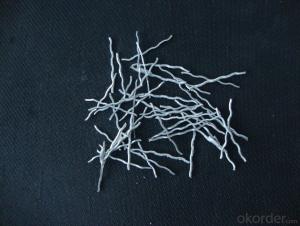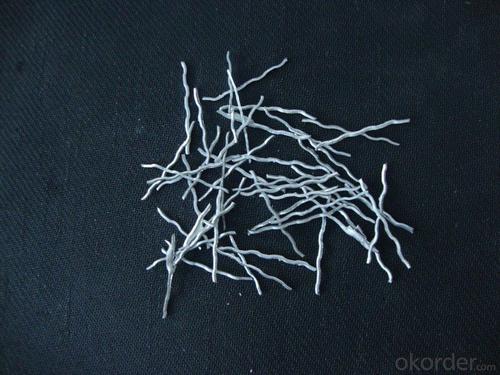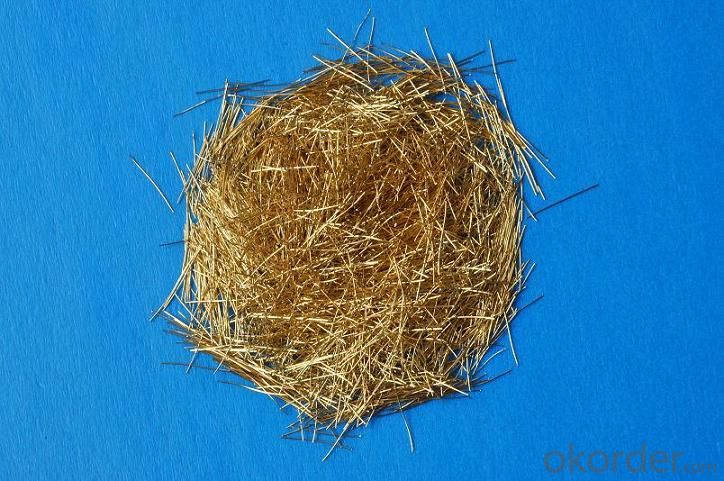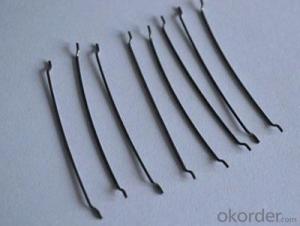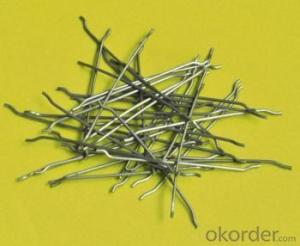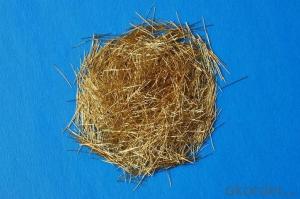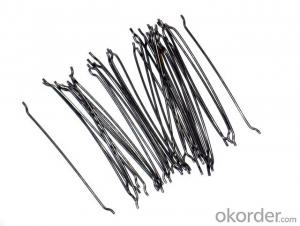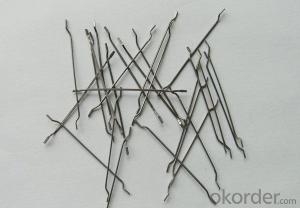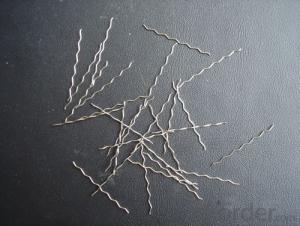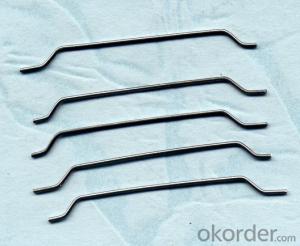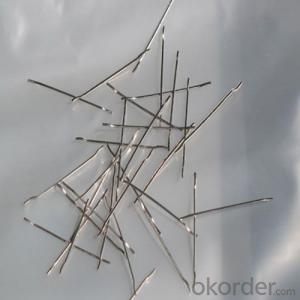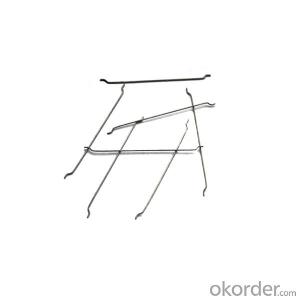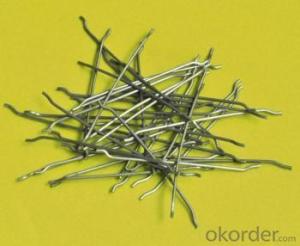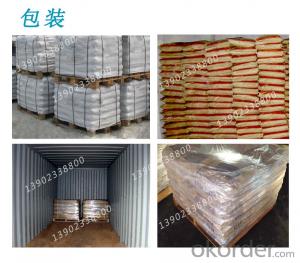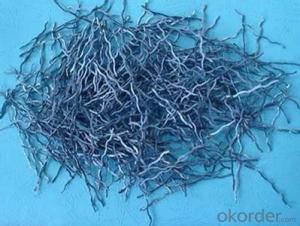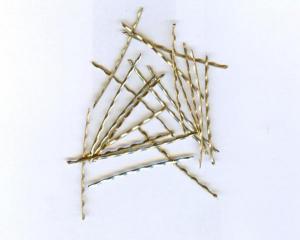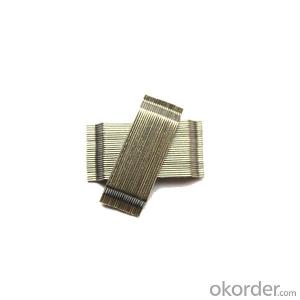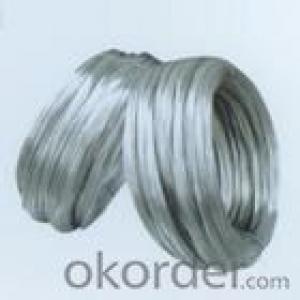Melt Extract Stainless Steel Fiber Straight Type with Hooked End for Concrete
- Loading Port:
- Tianjin
- Payment Terms:
- TT OR LC
- Min Order Qty:
- 1000 kg
- Supply Capability:
- 30000 kg/month
OKorder Service Pledge
Quality Product, Order Online Tracking, Timely Delivery
OKorder Financial Service
Credit Rating, Credit Services, Credit Purchasing
You Might Also Like
Quick Details
Place of Origin: China (Mainland)
Model Number: HHT
Material: Steel
or exceed the standerd of country's stipulation.
Our main produces are RPC coppercoated steel fiber, steel belt cuuting steel fiber and steel wire cutting steel fiber. Anual output is
15000 tons.Our raw materials are purchasing from famouse brand company in demestic.
Our products are widely used in expressway, high speed railway, industrial terrace, tunnel, bridge, airport runway and so on.We have
sold our steel fiber to lots of province of China and a lot of countrys and areas, such as korea, japan, austrilia mid-east, south asia
and so on.
Specifications
1. Directadding steel fibers to the belt,the rows of steel fiber as a whole,each of the concrete uniformly dispersed Corner
2. A water-soluble glue starts to dissolve,in a row of steel fibers in a dispersion premise,dispersed again in every corner of the monofilament fiber,showing a perspective view in the concrete of the fiber web, which play the role of an overall reinforcement.
3. Compare to the monofilament fiber,the glued steel fiber wouldn't be tied up,to ensure that the fibers in the concrete mixing does not agglomerate,distributed evenly.
High tensile strength ≥1100mpa
Good bending ductility
Better liquidity and decentrality
Lower price
Usage: Industiral terrace/ The dam slope protection/ Bridge floor/ Expansion joint/ Military engineering/ Concrete precast block/
Express way Air port runway/ Tunnel project
Picture
PP bag
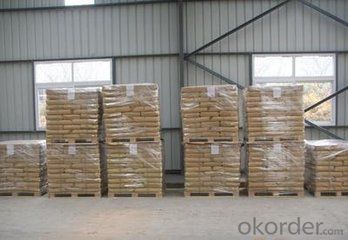
any type
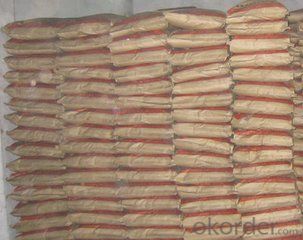
any type steel fiber
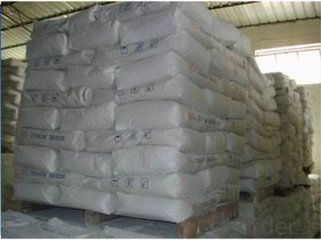
FAQ
hooked end steel fiber
Steel fiber straight type
ISO 9001 certificated
70% for Europe, Middle Asia, America market
Have the most number of steel fiber machine in china
- Q: How does the addition of melt extract stainless steel fiber impact the flowability of concrete?
- The addition of melt extract stainless steel fiber improves the flowability of concrete by enhancing its workability and reducing segregation. The fibers act as reinforcement, increasing the cohesiveness and viscosity of the concrete mix. This results in a more uniform and consistent flow, allowing for easier placement and better consolidation of the concrete.
- Q: Can melt extract stainless steel fiber be used in pre-stressed or post-tensioned concrete?
- Yes, melt extract stainless steel fiber can be used in pre-stressed or post-tensioned concrete. The high tensile strength and durability of stainless steel fibers make them suitable for these applications, as they can enhance the overall strength and performance of the concrete.
- Q: Can melt extract stainless steel fiber be used in architectural concrete finishes?
- Indeed, melt extract stainless steel fiber is a viable option for incorporating into architectural concrete finishes. It is common practice to utilize stainless steel fibers in concrete to augment its mechanical properties and bolster its longevity. The inclusion of stainless steel fibers in architectural concrete finishes can furnish supplementary reinforcement, diminish the likelihood of cracking, and heighten the aesthetic appeal of the concrete. The melt extract stainless steel fibers, in particular, are exceptionally well-suited for architectural concrete finishes due to their remarkable strength, resistance to corrosion, and superb adhesion with the concrete matrix. Moreover, these fibers can be effortlessly integrated into the concrete mixture, facilitating the creation of intricate designs and intricate details in architectural finishes. Overall, the utilization of melt extract stainless steel fiber is a fitting and advantageous enhancement for architectural concrete finishes.
- Q: Are there any specific curing requirements for concrete with melt extract stainless steel fiber?
- Yes, there are specific curing requirements for concrete with melt extract stainless steel fiber. Firstly, it is important to note that the inclusion of stainless steel fibers in concrete can significantly enhance its mechanical properties, such as tensile strength and resistance to cracking. However, the presence of these fibers can also affect the curing process and require certain considerations. One key requirement is to ensure adequate moisture during the curing process. Concrete with stainless steel fibers should be kept moist to prevent premature drying, as this can lead to shrinkage and cracking. Moist curing methods, such as using wet burlap or plastic sheets, can be employed to retain moisture and promote proper hydration of the concrete. Additionally, temperature control is crucial during the curing period. High temperatures can accelerate the hydration process, leading to increased shrinkage and potential cracking. On the other hand, low temperatures can hinder the curing process and result in reduced strength development. Therefore, maintaining a moderate and consistent temperature is essential for the proper curing of concrete with stainless steel fibers. Furthermore, it is advisable to extend the duration of the curing period for concrete with stainless steel fibers. This is because the fibers may impede the movement of water within the concrete matrix, slowing down the hydration process. By extending the curing time, the concrete has more opportunity to develop its desired strength and durability. Lastly, it is crucial to follow the manufacturer's recommendations regarding curing requirements for concrete with melt extract stainless steel fibers. Different fiber types and manufacturers may have specific guidelines and recommendations for curing, which should be followed to ensure optimal performance of the concrete. In summary, curing requirements for concrete with melt extract stainless steel fibers include maintaining moisture, controlling temperature, extending the curing period, and following manufacturer guidelines. By adhering to these requirements, the concrete can achieve its desired strength and durability while benefiting from the enhanced properties provided by the stainless steel fibers.
- Q: What is the effect of melt extract stainless steel fiber on the thermal conductivity of concrete?
- The thermal conductivity of concrete can be greatly improved by incorporating melt extract stainless steel fiber. Stainless steel fibers possess excellent thermal conductivity properties, enabling them to effectively transfer heat throughout the concrete. When these fibers are added to the concrete mixture, they create a three-dimensional network that aids in the efficient conduction and distribution of heat. This enhanced thermal conductivity has multiple positive impacts on the performance of the concrete. To begin with, the heightened thermal conductivity can enhance the overall thermal efficiency of structures constructed with this particular type of concrete. It facilitates better heat transfer, leading to more efficient temperature regulation and reducing the need for additional insulation or heating and cooling systems. Furthermore, the improved thermal conductivity can also enhance the durability of the concrete. By evenly distributing heat and minimizing temperature variations, the risk of thermal cracking and damage due to expansion and contraction is diminished. This is particularly advantageous in environments with substantial temperature fluctuations. Moreover, the greater thermal conductivity provided by melt extract stainless steel fiber can also be beneficial in applications like radiant floor heating systems. The fibers effectively transfer heat from the heating elements to the surface, resulting in more efficient and effective heating. In conclusion, the incorporation of melt extract stainless steel fiber in concrete significantly improves its thermal conductivity. This improvement leads to increased thermal efficiency, enhanced durability, and improved performance in various applications where heat transfer is crucial.
- Q: Can melt extract stainless steel fiber be used in high-rise or tall buildings?
- Yes, melt extract stainless steel fiber can be used in high-rise or tall buildings. This type of fiber is known for its high strength and durability, making it suitable for various construction applications, including reinforcing concrete in tall buildings. It can enhance the structural integrity and resistance to cracking, improving the overall performance and safety of the building.
- Q: Can melt extract stainless steel fiber be used in concrete pipes or culverts?
- Yes, melt extract stainless steel fiber can be used in concrete pipes or culverts.
- Q: How does melt extract stainless steel fiber improve the resistance to spalling in concrete?
- The addition of melt extract stainless steel fibers to concrete enhances its resistance to spalling by reinforcing and increasing its overall durability. These stainless steel fibers disperse evenly throughout the concrete, creating a three-dimensional network that acts as reinforcement. This reinforcement improves the concrete's tensile strength and crack resistance. Spalling, which is the chipping, flaking, or peeling off of the concrete surface, can occur due to freeze-thaw cycles, high temperatures, or chemical exposure. However, the inclusion of melt extract stainless steel fibers helps prevent cracks from spreading and reduces the expansion and contraction of the concrete, mitigating these effects. The high tensile strength of stainless steel fibers allows them to absorb and distribute stress in the concrete, preventing crack formation and minimizing the impact of external forces. Additionally, the corrosion-resistant properties of stainless steel ensure the fibers remain intact and do not deteriorate over time, providing long-term reinforcement. Furthermore, the three-dimensional network formed by the stainless steel fibers helps bridge any cracks that may develop in the concrete. This bridging effect prevents the cracks from widening and propagating, significantly reducing the likelihood of spalling. In conclusion, melt extract stainless steel fiber improves concrete's resistance to spalling by reinforcing the material, increasing its tensile strength, reducing crack propagation, and enhancing its overall durability. By incorporating these fibers into the concrete mix, the risk of spalling due to freeze-thaw cycles, high temperatures, or chemical exposure is greatly minimized, resulting in a more resilient and long-lasting concrete structure.
- Q: What is the effect of melt extract stainless steel fiber on the drying shrinkage of concrete?
- Typically, the effect of melt extract stainless steel fiber on concrete's drying shrinkage is positive. These fibers are added to the concrete mix to help decrease overall drying shrinkage and the likelihood of cracks forming. During the drying process, concrete tends to shrink as the water evaporates. This shrinkage can create cracks, which can compromise the structure's strength and longevity. However, when melt extract stainless steel fibers are incorporated into the concrete mix, the shrinkage is significantly reduced. These fibers serve as reinforcement within the concrete, distributing stresses and strains more evenly. As a result, the chances of cracking during the drying process are reduced. Melt extract stainless steel fibers possess high tensile strength and excellent corrosion resistance, making them an ideal choice for this purpose. They also enhance durability and increase resistance to cracking caused by shrinkage and temperature fluctuations. To summarize, the addition of melt extract stainless steel fibers effectively minimizes drying shrinkage in concrete and decreases the risk of cracking. Consequently, it enhances the durability and longevity of the concrete structure.
- Q: Can melt extract stainless steel fiber be used in tunnel segments?
- Melt extract stainless steel fiber is indeed applicable for tunnel segments. It is a common practice to incorporate stainless steel fibers into concrete mixtures for the purpose of enhancing the material's mechanical properties and increasing its durability. By incorporating stainless steel fibers, the strength and crack resistance of concrete segments in tunnel construction can be significantly improved, thereby minimizing the likelihood of structural failures. Furthermore, stainless steel fibers offer superior resistance to corrosion, making them a suitable choice for tunnel segments that may face moisture or aggressive environments. Consequently, melt extract stainless steel fiber can be utilized effectively in tunnel segments to enhance their structural integrity and prolong their lifespan.
Send your message to us
Melt Extract Stainless Steel Fiber Straight Type with Hooked End for Concrete
- Loading Port:
- Tianjin
- Payment Terms:
- TT OR LC
- Min Order Qty:
- 1000 kg
- Supply Capability:
- 30000 kg/month
OKorder Service Pledge
Quality Product, Order Online Tracking, Timely Delivery
OKorder Financial Service
Credit Rating, Credit Services, Credit Purchasing
Similar products
Hot products
Hot Searches
Related keywords
